Carpenter Ants

Ants: It has been reported that there are over 12,000 species of ants in the world that have already been identified, and of those only about 1,000 make their home in North America. Only 1,000, about thirteen percent (13%) are considered pests, invading urban areas here in North America. Only about 50 of the 13% may cause frequent problems. Ants are highly evolved and can be considered a dominant insect group, being one of the largest family group of insects in terms of sheer number of individual ants and number of different species. Ants and the various species can be found all over the world from the cold subarctic tundra to the hot dry deserts. A majority of ants originate from the tropics.
Carpenter ants are social insects that make their colonies primarily in wood. They hollow out wood to build their nests, making their galleries and chambers velvety-smooth as if a carpenter had sanded the surfaces. Their tunneling in wood and foraging for food and water lead to their “pest” status in and around homes.
The presence of carpenter ants can mean that a building has problems that need attention, such as moisture, rotting wood or other conditions conducive to ant infestation. In Texas, there are at least 14 species of carpenter ants that destroy wood.
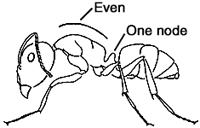
Biology and Habits
The ants develop through several stages of metamorphosis: egg, larva, pupa and adult. All four stages can be found in a colony. The adults have six legs, three distinct body regions with a constricted waist, and prominent, elbowed antennae. They can be solid black, yellowish red, or a combination of black, red and reddish orange. A carpenter ant has only one segment or node between the thorax and abdomen. It also has a circle of hairs at the tip of the abdomen and an evenly rounded thorax when viewed from the side.

Winged carpenter ants resemble winged termites and, in Texas, it is not uncommon for both of these important wood-destroying insects to swarm at about the same time. It is vital that they be identified accurately, because control measures differ greatly for the two insect groups. Click termites to learn about them
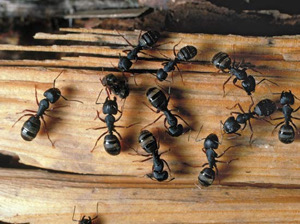
Ants have small, constricted waists. Their wings are of unequal length, with the front pair longer than the hind pair. Their antennae are bent at right angles about mid-length. Termite bodies are not narrowed at the middle. Their wings are of equal length, and their antennae are rather straight with bead-like segments. As shown above

Mature carpenter ant colonies produce male and female winged reproductives from early spring to summer. Environmental conditions cause them to emerge and swarm. They mate during these swarms or nuptial flights, which may occur over several days or weeks. After the nuptial flight, males die and females begin searching for a nesting site.
After establishing the nest, the female deposits 15 to 20 eggs. The queen cares for the initial larvae and feeds them with fluids secreted from her body. Under favorable conditions, the eggs progress through the larval and pupal stages to become worker ants in about 2 months. After becoming adults, new workers expand the nest, excavate galleries and provide food for the queen and larvae.
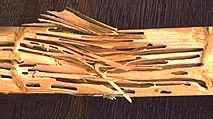
The first-generation worker ants are small. After foraging for food outside of the nest, worker ants return to regurgitate partially digested food to nourish developing larvae and the queen. Older larvae are fed solid food by the workers.
Carpenter ant colonies remain small during the first year, but they grow rapidly, and in 3 to 6 years will contain up to 3,000 ants. Winged reproductives are produced by older, mature colonies. Once colonies are mature, workers are produced continuously to replace those that die, while 200 to 400 winged individuals are produced each year for reproductive flights. Winged reproductives usually develop in late summer, spend winter in the nest, and swarm in spring and early summer.
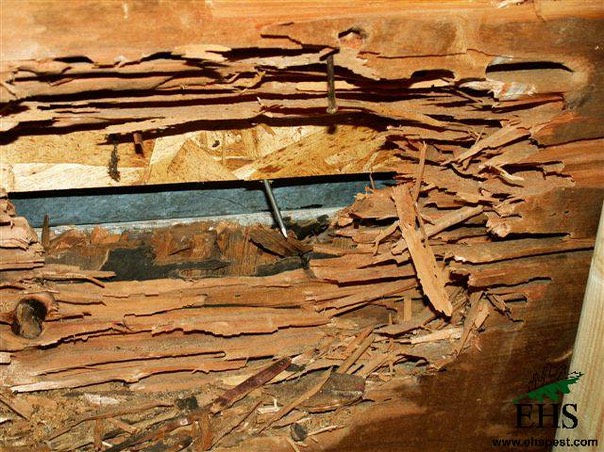
Nesting Sites
Carpenter ants normally build their nests in hollow trees, logs, posts, landscaping timbers and wood used in homes and other structures. Unlike termites, ants do not feed on wood but excavate galleries in wood as places to build nests. Carpenter ants prefer to nest in moist or decayed wood, frequently entering existing cavities or void areas through cracks and crevices.
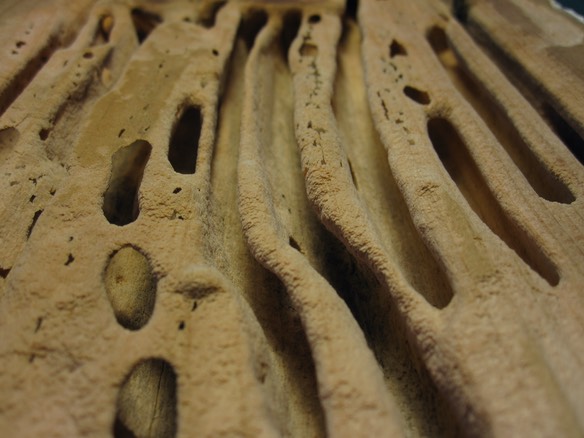
The ants usually cut galleries with the grain of the wood, following the softer parts. They leave the harder wood as walls separating the tunnels, but cut openings in these walls to connect the galleries. Access to the outside may be through natural openings, or the ants may cut openings where none exist.
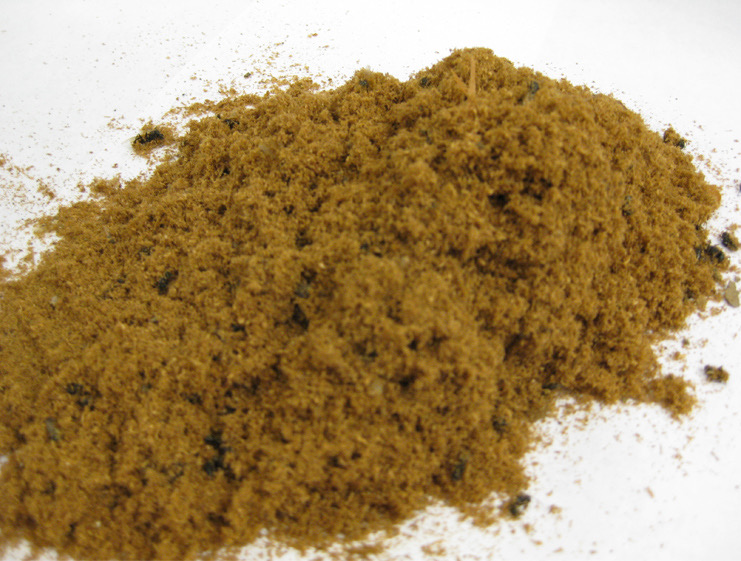
Occupied galleries are kept very clean. Shredded wood fragments from the excavations are carried from the nest and placed outside. Cone-shaped piles of these fragments, often called frass piles, sometimes build up beneath the nest openings. Frass piles may also contain excretions, dead carpenter ants, and bits of wood, sand, soil or insulation and may vary in color.
Frass is not always visible because ants may dispose of it in hollow parts of trees, in void areas in structures, or in unused galleries within the nest.
Carpenter ants become pests when they nest or forage for food in homes and other buildings. Usually, an infestation occurs when all or part of an existing colony moves into a house from outside. Ants enter structures through several common routes: where tree branches or utility lines contact a structure, through cracks and crevices around windows and in foundation walls, through ventilation openings in the attic, and through heating or air-conditioning ducts.
Carpenter ants like to nest in wood that is very moist or has been previously damaged by water or termites. A colony develops best in wood with a moisture content of more than 12 to 15 percent. This can happen where there is a leak, condensation or continuously high, relative humidity. Typical nest locations include:
- wood affected by water seepage from plugged drain gutters, damaged flashing, wood shingle roofs, poorly fitted or damaged siding, improper pitch of porch floors, or leaking door and window frames;
- wood between the roof and ceiling of flat-deck porches;
- areas around plumbing in kitchens and bathrooms where water leaks have soaked the surrounding wood; • wood in contact with soil, such as porch supports, siding and stair risers;
- wood in areas of poor ventilation or condensation, such as cellars, crawl spaces, attics and under porches;
- wood scraps in dirt-filled slab porches;
- voids under bathtubs or hot tubs;
- hollow wooden doors, hollow ceiling beams, hollow shower and curtain rods, and hollow porch posts and columns;
- window sill plates and floor joists;
- voids under attic insulation or under insulation in crawl spaces; and
- voids above windows and doors.